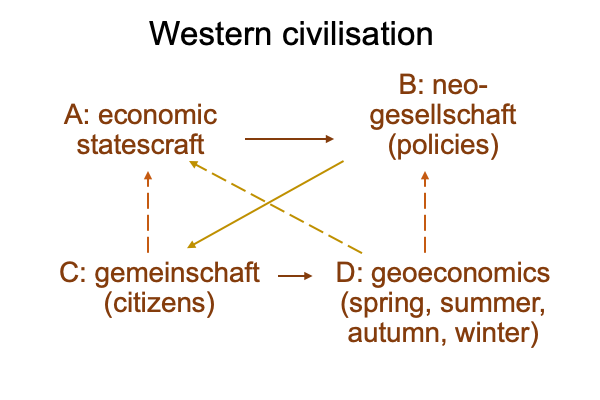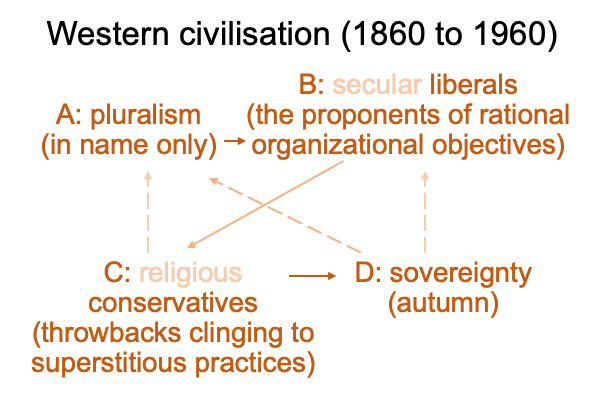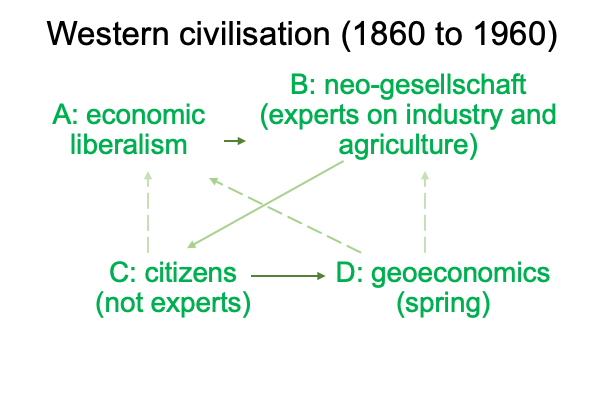0110 The economic overtones in the political cycle of Western civilisation are obvious.
Part three of Diesen’s book concerns the rise and the fall of economic liberalism.
Economic liberalism asks the government to avoid market interventions. The French call the attitude, “laissez faire”, roughly translated as “let the market do what it is going to do“.
0111 Okay, what does the corresponding Greimas square look like?
Laissez faire is a type of economic statescraft. So, economic statescraft goes into A.
Neo-gesellschaft policies associate to B. These policies propose rational interventions under the appearance that one is leaving the markets do what they are going to do.
The citizens (C) do not notice any problem, because they follow appearances. For example, to an atheist, a religious ritual is pure appearance. So, who is going to object to the il(liberal) nature of neo-gesellschaft policies?
The grand idea beneath economic statescraft (A) is geoeconomics (D).
0112 Here is Diesen’s Greimas square for geoeconomics (D).

0113 Diesen notes that economic statescraft (A) aims to advance the nation in terms of autonomy (freedom from dependence on other nation-states) and influence (by promoting dependence by other nation states). Sovereign interventions occur in the face of international challenges (B). Policy (B) imperatives include (B1) controlling strategic industries and (B2) transportation corridors, (B3) regulating financial and economic cooperation and (B4) preserving gemeinschaft and social cohesion.
Ah, this must mean that economic liberalism is a style of economic statescraft (A).
0114 Next, Diesen discusses the rise of Britain, the ascendancy of the USA and the geo-economics of Western Europe, starting around the 1850s.
What does this imply?
I recall a season in the civilizational cycle of political liberalism (that is, pluralism) starting around 1860 AD. This season corresponds to autumn.
Here is a picture.

0115 Weirdly, the rise of economic liberalism (as portrayed by Diesen) seems to correspond to this same period.

0116 Now, when I consider these two Greimas squares, occurring at the same time, I realize that political and economic civilizational cycles may not directly correspond. Autumn for one attribute may be spring for another.
0117 What about a slot by slot comparison?
Economic liberalism (A) compares to pluralism (in name only) (A). In the former, there is a balance between gesellschaft and gemeinschaft, in so far as the entire nation benefits from rational policies (B1-B4). In the latter , gesellschaft has dominion over gemeinschaft and the balance between the two is tottering, because “scientific” rationalist liberals define organizational objectives that promote their world rather than the world of “unscientific” conservatives.
Secular liberals propose rational organizational objectives (all of which increase the power of central planners (B)). Neo-gesellschaft oriented experts apply so-called “scientific” principles to increase productivity in both industry and agriculture (B). Larger corporations are able to sustain the regulatory burdens better than small family-oriented businesses.
Religious conservatives are derided as backwards (C) even though, as citizens (C), they are doing pretty well as the state pursues objectives that lessen economic dependency on other nations and increases economic dependency by other nations. Bureaucrats aim for a favorable “trade balance”. Industrial capitalism pleases traditional conservative citizens. Some of these citizens even put their money into banks, instead of under their mattresses.
Finally, the autumn of sovereignty (D) and the spring of geoeconomics (D) coincide.
